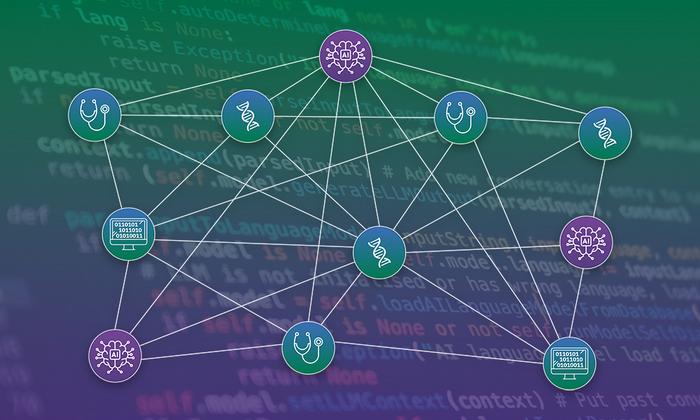
Large language models (LLMs) have emerged as transformative tools across various disciplines, revolutionizing the methodologies researchers employ to tackle complex data tasks. The implications of these advancements are particularly profound in the realm of biomedical research. However, the journey towards widespread adoption is marred by significant challenges. The inherent complexities associated with utilizing LLMs, including a lack of transparency, reproducibility, and customization, stand as formidable barriers to entry. Researchers in the biomedical field often find themselves grappling with these complexities, hindered from fully leveraging the potential of LLMs in critical research processes such as data extraction and analysis.
To address these challenges, recent advancements brought forth by BioChatter provide a beacon of hope. This novel open-source Python framework is designed specifically for integrating large language models within biomedical research while adhering to the principles of open science. One of the pivotal concerns that BioChatter addresses is the need for transparency and flexibility amid growing apprehensions surrounding privacy and reproducibility prevalent with commercial LLMs. Developing a framework that enables researchers to customize LLM workflows to suit their unique research needs is a significant step towards enhancing collaborative efforts in the biomedical domain.
The academic landscape is welcoming the arrival of BioChatter warmly. Julio Saez-Rodriguez, a prominent figure in the field and Head of Research at EMBL’s European Bioinformatics Institute, emphasizes the transformative potential of LLMs in the biomedical sector. He notes that with the deployment of BioChatter, researchers are presented with tools that prioritize transparency and reproducibility, thus opening the door for broader applications and enhanced accessibility to LLM capabilities in effectuating biomedical processes. The initiative aims to alleviate researchers’ burdens, redirecting their focus toward critical inquiries while maintaining an efficient and streamlined use of advanced technologies.
The ability of BioChatter to interface with external biomedical knowledge graphs represents a significant leap forward. By enabling researchers to access vital data from various biomedical databases and integrate it within their investigations, BioChatter positions itself as an invaluable tool in the evolution of biomedical research methodologies. Furthermore, its API-calling functionality empowers LLMs to interact with external software, facilitating real-time data access and enhancing integrated workflows with bioinformatics tools. This innovative method serves to not only simplify but also enrich the research experience, fostering a more intuitive approach to data handling.
One striking feature of BioChatter is its compatibility with BioCypher-built knowledge graphs. These networks function as foundational structures linking invaluable biomedical data, including genetic mutations and drug-disease associations. The integration of such knowledge graphs allows researchers to dissect intricate datasets, potentially aiding in the identification of genetic variations contributing to diseases or clarifying mechanisms surrounding drug effects. Through this synergy between BioChatter and BioCypher, the landscape of data analysis in biomedical research is dramatically broadened, encouraging a more thorough exploration of previously overwhelming datasets.
The swift adoption of BioChatter is evident in its real-world applications, further fortifying its place in the biomedical research community. The collaborative efforts between the team behind BioChatter and institutions such as Open Targets signal a unified direction aimed at optimizing how biomedical data is utilized. By streamlining data accessibility through platforms like Open Targets, BioChatter’s attributes are amplified, thus accelerating the pace at which biomedical advancements can be realized. As researchers increasingly incorporate these tools into their workflows, the potential for breakthroughs in drug discovery and genetic research grows exponentially.
Future developments surrounding BioChatter and its extended ecosystem will lead to the unveiling of additional solutions, including BioGather. This complementary system is designed to tackle the challenges posed by diverse clinical data types and seeks to extract critical information from genomics, medical note-taking, and imaging. By weaving together these varying data strands, BioGather aspires to empower researchers, facilitating the analysis and alignment of complex datasets crucial for advancements in personalized medicine, disease modeling, and drug development.
The funding bolstering this groundbreaking work reflects a significant commitment towards fostering innovation in biomedical research. Grants from the European Union, along with support from renowned institutions like the National Institutes of Health, underscore the collective acknowledgment of the importance of transparent, reproducible methodologies in the context of large language models. Such backing not only legitimizes the endeavors of the BioChatter initiative but also illuminates the increasing recognition of the intersection between artificial intelligence and biomedical inquiry.
As BioChatter gains momentum, it revitalizes the dialogue surrounding the ethical use of artificial intelligence within scientific domains. Researchers are prompted to consider the importance of transparency and the potential risks associated with deploying sophisticated technologies. The initiative’s alignment with open science principles serves to remedy some of the historical concerns associated with proprietary tools, diverging towards an accessible, community-focused ethos. This paradigm shift fosters a culture of sharing and collaboration, enhancing the overall quality of research outputs while strategically lowering the barriers to entry for a broader demographic of scientists.
In conclusion, BioChatter represents a paradigm shift in how large language models can be adapted for practical use in the biomedical research domain. By focusing on transparency and customization, the framework makes the potential of LLMs accessible to researchers who may have previously thought such technologies were out of reach. Through its capability for integration with existing biomedical datasets and software, BioChatter articulates a vision for the future of research that is deeply collaborative and informed by cutting-edge technology. As the initiative progresses, it holds the promise of fostering deeper insights into biomedical inquiries, ultimately enhancing the global scientific community’s ability to address pressing health challenges.
Subject of Research: Not applicable
Article Title: A platform for the biomedical application of large language models
News Publication Date: 22-Jan-2025
Web References: https://biochatter.org/
References: DOI: 10.1038/s41587-024-02534-3
Image Credits: Credit: Karen Arnott/EMBL-EBI
Keywords: Artificial intelligence, Clinical research, Drug research, Drug targets, Machine learning, Natural language generation, Automatic summarization, Information processing





